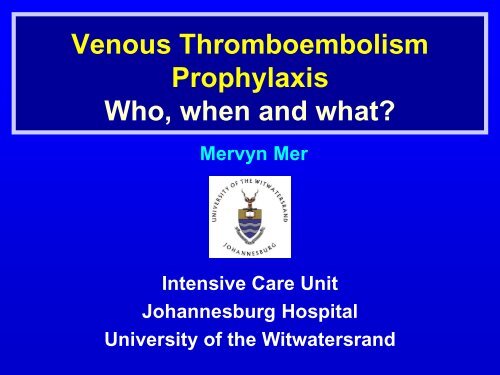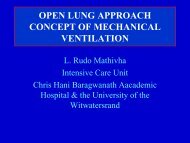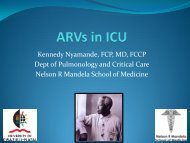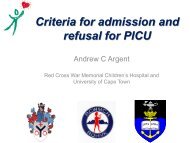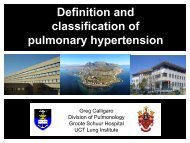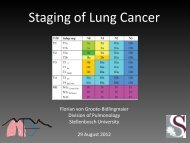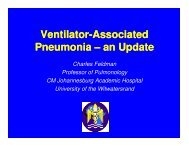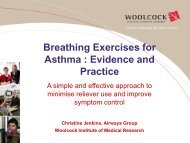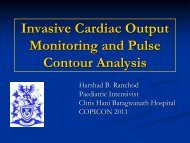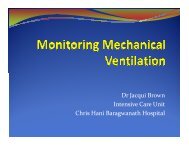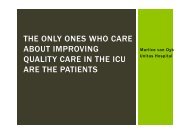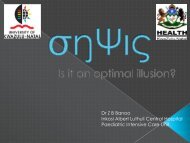Venous Thromboembolism Prophylaxis Who, when and what?
Venous Thromboembolism Prophylaxis Who, when and what?
Venous Thromboembolism Prophylaxis Who, when and what?
You also want an ePaper? Increase the reach of your titles
YUMPU automatically turns print PDFs into web optimized ePapers that Google loves.
<strong>Venous</strong> <strong>Thromboembolism</strong><br />
<strong>Prophylaxis</strong><br />
<strong>Who</strong>, <strong>when</strong> <strong>and</strong> <strong>what</strong>?<br />
Mervyn Mer<br />
Intensive Care Unit<br />
Johannesburg Hospital<br />
University of the Witwatersr<strong>and</strong>
Introduction <strong>and</strong> Background<br />
Virchow’s triad<br />
describes predisposing factors<br />
to venous thrombosis<br />
• Stasis<br />
• Hypercoagulability<br />
• Endothelial damage<br />
Risk factors present in > 90% cases<br />
Virchow R. In : Virchow R , ed. Gesammelte<br />
Abh<strong>and</strong>lungen zur wissenschaftlichen Medizen.<br />
Frankfurt : Meidinger ; 1856 : 478-86
VTE Facts<br />
• 3 rd most common type cardiovascular disease<br />
• > 500 000 deaths in Europe <strong>and</strong> 300 000 deaths in USA / yr<br />
• Cause of in-hospital mortality in 1 in 8 patients<br />
• Number of in-hospital deaths due to VTE is 5 x the total<br />
number of deaths from all hospital-acquired infections<br />
Goldhaber SZ. Thromb Haemost 2007; 5:1607-1609<br />
Cohen AT, et al. Thromb Haemost 2007; 98: 756-764<br />
Heit JA, et al. ASH Annual meeting Abstracts 2005; 106: 910<br />
Fitzmaurice DA, et al. Br Med J 2007; 334: 1017-1018
VTE Facts<br />
• Deaths attributable to VTE estimated to exceed total<br />
combined number of deaths from breast cancer,<br />
prostate cancer, AIDS <strong>and</strong> traffic accidents combined<br />
• Commonest preventable cause of hospital death<br />
• Doubles length of stay <strong>and</strong> costs<br />
• ~ 70% hospital-acquired<br />
Fitzmaurice DA, et al. Br Med J 2007; 334: 1017-1018<br />
S<strong>and</strong>ler DA, et al. J R Soc Med 1989; 89: 203-5<br />
Geerts WH, et al. Chest 2008; 381S-453S
Pulmonary Embolism<br />
• Most cases recognised by the true expert in<br />
this field …………
Pulmonary Embolism<br />
• Most cases recognised by the true expert in<br />
this field ………… the pathologist
Prevention Strategies<br />
• Pharmacological interventions<br />
• Physical methods
Prevention Strategies<br />
• Prophylactic drugs<br />
- unfractionated heparin (UF)<br />
- low molecular weight heparin (LMWH)<br />
- oral anticoagulants : coumarins<br />
- thrombin inhibitors : hirudin<br />
- indirect factor Xa inhibitors : fondaparinux<br />
- new oral agents : Dabiatran , Rivaroxaban
Prevention Strategies<br />
• Prophylactic physical methods<br />
- graduated compression stockings<br />
- intermittent pneumatic compression devices<br />
- early mobilisation<br />
Improve endogenous fibrinolysis <strong>and</strong> increase<br />
venous blood flow
Risk of DVT in hospitalised patients<br />
If no prophylaxis given + routine screening for DVT<br />
Patient group<br />
Medical patients<br />
General surgery<br />
Major gynecological surgery<br />
Major urologic surgery<br />
Neurosurgery<br />
Stroke<br />
Hip, knee arthroplasty, hip fracture<br />
Major trauma<br />
Spinal cord injury<br />
DVT prevalence (%)<br />
10-20<br />
15-40<br />
15-40<br />
15-40<br />
15-40<br />
20-40<br />
40-60<br />
40-80<br />
60-80<br />
Moderate<br />
risk<br />
High<br />
risk<br />
Critical Care patients 10=80%<br />
Geerts WH, et al. Chest 2008; 133: 381S- 453S
Thromboprophylaxis<br />
What is the evidence?<br />
• Hundreds of r<strong>and</strong>omised trials<br />
• Thromboprophylaxis reduces:<br />
• DVT<br />
• PE<br />
• all-cause mortality<br />
• costs
Thromboprophylaxis…<br />
What is the evidence?<br />
• Thromboprophylaxis is the number 1<br />
ranked patient safety practice in<br />
hospitalised patients<br />
• More than 25 published evidence-based<br />
guidelines since 1986 showing clear<br />
evidence of benefit <strong>and</strong> safety
Anticoagulation is Effective<br />
Comparison of thrombophylaxis vs. no thromboprophylaxis<br />
Numbers needed to treat to prevent one additional episode<br />
• DVT : 7<br />
• Symptomatic PE : 143<br />
• Fatal PE : 182<br />
• All-cause mortality : 97<br />
Geerts W et al. Chest 2008; 133: 381-453
Thromboprophylaxis in moderate risk patients<br />
Patients<br />
• Medical<br />
• Surgical<br />
- general, gynaecological,<br />
urologic, neurosurgery<br />
Options<br />
Duration<br />
• Low molecular weight heparin<br />
• Low dose heparin<br />
• Fondaparinux<br />
• Mechanical if high bleeding risk<br />
• Until discharge<br />
Geerts WH, et al. Chest 2008; 133: 381S- 453S
Thromboprophylaxis in high risk patients<br />
Patients<br />
Options<br />
Duration<br />
• Major orthopaedic hip <strong>and</strong> knee<br />
arthropalasty, hip fracture repair<br />
• Major trauma<br />
• Low molecular weight heparin<br />
• Fondaparinux<br />
• Warfarin (INR 2-3)<br />
• Mechanical if high bleeding risk<br />
• At least 10 days (2-5 weeks)<br />
Geerts WH, et al. Chest 2008; 133: 381S- 453S
8 th ACCP Guidelines on Antithombotic Therapy<br />
1.2 VTE <strong>Prophylaxis</strong> Policy<br />
1.2.1 We recommend that every general<br />
hospital develop a formal, active strategy<br />
that addresses the prevention of VTE<br />
[Grade 1A]<br />
Geerts WH, et al. Chest 2008; 133: 381S- 453S
Compliance with <strong>Prophylaxis</strong> Guidelines for<br />
VTE<br />
• Retrospective evaluation compliance in hospitalised<br />
patients at risk for VTE wrt ACCP thromboprophylaxis<br />
guidelines<br />
• 123 304 hospital admissions, 2001-2005<br />
• Only 15.3% at-risk patients received prophylaxis in<br />
accordance with guidelines<br />
- omission, inadequate prophylaxis duration, wrong type<br />
• Conclusion<br />
Poor compliance with guidelines for thromboprophylaxis<br />
Yu HT, et al. Am J Health Syst Pharm 2007; 64 :69-76
Current Rates of <strong>Prophylaxis</strong><br />
ENDORSE Study<br />
• Large international trial; 32 countries<br />
• 68 183 patients; 358 hospitals<br />
• Risk for VTE common : 52% patients<br />
- 64% surgical cases & 42% medical cases<br />
• Only 59% surgical patients <strong>and</strong> 40% medical<br />
at risk patients received prophylaxis<br />
Cohen AT, et al. Lancet 2008: 371:387-94
National st<strong>and</strong>ards for prevention <strong>and</strong> care of VTE:<br />
VTE Performance Measures<br />
VTE Risk Assessment/<strong>Prophylaxis</strong><br />
All patients should receive VTE prophylaxis within 24<br />
hours of hospital admission or surgery end time (or have<br />
documentation why no prophylaxis was given)<br />
www.qualityforum.org.projects/ongoing/vet/comments/index.asp
S Afr Med J 2009; 99: 467- 473
<strong>Venous</strong> <strong>Thromboembolism</strong> –<br />
prophylactic <strong>and</strong> therapeutic practice guideline<br />
• Reflect current best practice<br />
• Assess each patient on merit <strong>and</strong> individualise<br />
• Drug recommendations based on current MCC<br />
registration<br />
S Afr Med J 2009; 99: 467- 473
Risk Assessment<br />
• Patient- related risk factors<br />
- age, previous history VTE, immobility, underlying<br />
malignancy, pregnancy, oestrogen replacement<br />
therapy, obesity, underlying hereditary thrombophilic<br />
state, underlying inflammatory bowel disease, HIV<br />
• Procedure- related risk factors<br />
- duration of procedure, degree of tissue damage,<br />
degree immobility post surgery, nature surgical procedure<br />
S Afr Med J 2009; 99: 467- 473
Thrombophilia<br />
History of VTE<br />
Malignancy<br />
Drugs, e.g.<br />
• Tuberculosis treatment<br />
• Steroids<br />
HIV infection<br />
• Thalidomide<br />
Advanced age (>60yrs = VTE risk)<br />
Chronic cardiac insufficiency<br />
Obesity (BMI >30 kg/m 2 )<br />
Oestrogen therapy<br />
Pregnancy & the postpartum period<br />
Nephrotic syndrome<br />
Varicose veins<br />
Predisposing risk<br />
factor<br />
Relative risk<br />
weighting<br />
High<br />
High<br />
High<br />
High<br />
High<br />
Moderate<br />
Moderate<br />
Moderate<br />
Moderate<br />
Minor<br />
Minor<br />
Minor
Subcategories of VTE risk in<br />
surgical <strong>and</strong> non-surgical patients<br />
Low VTE Risk<br />
Surgical patients<br />
• Surgery lasting < 30 minutes<br />
• Injuries without or with only<br />
minor soft tissue trauma<br />
• No or only minor, additional<br />
predisposing risk factors<br />
Medical patients<br />
• Infection or acute inflammatory<br />
disease without bed rest<br />
• Central venous catheters<br />
• No or only minor, additional<br />
predisposing risk factors
Subcategories of VTE risk in<br />
surgical <strong>and</strong> non-surgical patients<br />
Moderate VTE Risk<br />
Surgical patients<br />
• Surgery procedures of longer<br />
duration<br />
• Immobilisation of lower limb<br />
with plaster cast<br />
• Lower limb arthroscopic<br />
procedures<br />
• No or only minor, additional<br />
predisposing risk factors<br />
Medical patients<br />
• Acute cardiac insufficiency<br />
(NYHA III/IV)<br />
• Acute decompensated COPD<br />
without ventilation<br />
• Infection or acute inflammatory<br />
diseases with bed rest<br />
• No or only minor, additional<br />
predisposing factors
Subcategories of VTE risk in<br />
surgical <strong>and</strong> non-surgical patients<br />
High VTE Risk<br />
Surgical patients<br />
• Major surgical procedures for<br />
malignancy<br />
• Multiple trauma or severe<br />
trauma of the spine, vertebrae<br />
or lower limbs<br />
• Major orthopaedic surgery,<br />
e.g. hip or knee replacement<br />
• Major surgical procedure of<br />
cardiothoracic <strong>and</strong> pelvic<br />
region<br />
Medical patients<br />
• Stroke with paralysis<br />
• Acute decompensated COPD<br />
with ventilation<br />
• Sepsis<br />
• ICU patients
Medical Patients<br />
• Risk of DVT comparable to moderate-risk<br />
surgical patients<br />
• 75% of hospital related PE deaths<br />
• Efficacy of heparins in preventing VTE well<br />
established<br />
• LMWH or UFH (LMWH superior)<br />
S Afr Med J 2009; 99: 467- 473
Thromboprophylaxis of Medical Patients<br />
Clear benefits over placebo<br />
Study RRR NNT <strong>Prophylaxis</strong> Pts with VTE,<br />
%<br />
MEDENOX<br />
n=1102<br />
PREVENT<br />
n=3706<br />
ARTEMIS<br />
n=849<br />
63% 10 Placebo<br />
Enoxaparin<br />
40mg<br />
45% 45 Placebo<br />
Dalteparin<br />
47% 20 Placebo<br />
Fondaparinux<br />
14.9<br />
5.5<br />
5.0<br />
2.8<br />
10.5<br />
5.6<br />
Samama MM, et al. N Engl J Med 1999; 341: 793-800<br />
Leizorovicz A, et al. Circulation 2004; 110: 874-9<br />
Cohen AT, et al. J Thromb Haemostat 2003; 1: Suppl 1: 2046
Aspects of VTE Guideline<br />
• Timing of prophylaxis<br />
- controversial<br />
- spectrum: preoperatively to 6-12 hours postop<br />
• Duration<br />
- major cancer surgery : 5 weeks<br />
- hip replacement surgery : 5 weeks<br />
- knee replacement surgery : 2 weeks<br />
- prophylaxis should be continued until patient<br />
fully mobile<br />
S Afr Med J 2009; 99: 467- 473
Aspects of VTE Guideline<br />
Centroneuro-axial blockade<br />
• Catheters should not be placed or removed within 12<br />
hours of dose LMWH<br />
• LMWH can be given after 2 hours following insertion or<br />
removal<br />
• Fondaparinux : limited data<br />
- long half-life<br />
- catheter removal not < 36 hours after last dose<br />
S Afr Med J 2009; 99: 467- 473
Neuraxial blocks<br />
Several guidelines recommend “At least 2 half lives”
Arixtra with Epidural Catheters<br />
Fondaparinux (“Arixtra”)<br />
Half life 17 – 21 hours<br />
C Max 2 hours<br />
Last dose 2 half-lives Removal of<br />
Catheter<br />
8 – C Max Next dose<br />
21 x 2 =<br />
42 hours<br />
8 – 2 =<br />
6 hours<br />
8:00<br />
Day 1<br />
8:00<br />
Day 3<br />
2:00<br />
Day 3<br />
08:00<br />
8:00<br />
Day 3<br />
14:00
Clexane with Epidural Catheters<br />
Enoxaparin (“Clexane”)<br />
Half life 4 -5 hours<br />
C Max 1 - 4 hours<br />
Last dose 2 half-lives Removal of<br />
Catheter<br />
8 – C Max Next dose<br />
5 x 2 =<br />
10 hours<br />
8 – 4 =<br />
4 hours<br />
8:00 18:00 22:00<br />
8:00<br />
18:00<br />
Next day<br />
8:00
Monitoring of Patients on LMWH<br />
• Platelet count – check on initiation, after 5 days<br />
<strong>and</strong> regularly thereafter while on therapy<br />
• Anticoagulant activity measured using anti-Xa<br />
activity assay<br />
• Anti-Xa measurement – pregnancy, renal failure,<br />
excessively obese<br />
• 5 ml citrated blood taken 3 hrs post LMWH dose<br />
S Afr Med J 2009; 99: 467- 473
Monitoring of Patients on LMWH<br />
Target levels<br />
• <strong>Prophylaxis</strong> : 0.3 – 0.5 anti-Xa units / ml of blood<br />
• Therapeutic : 0.6 – 1.0 anti-Xa units / ml of blood<br />
• Pregnant patients with artificial cardiac valve :<br />
1 – 1.2 anti-Xa units / ml of blood<br />
S Afr Med J 2009; 99: 467- 473
Adequate Thromboprophylaxis in<br />
Critically Ill Patients<br />
• Critically ill patients may need much higher<br />
doses of LMWH than other patients<br />
• Reasons<br />
- full immobilisation<br />
- limited bioavailability (oedema, vasopressors)<br />
- impaired protein binding<br />
Robinson S, et al. Critical Care 2010; 14: R41<br />
Levi M. Critical Care 2010; 14: 142<br />
Priglinger U, et al. Crit Care Med 2003; 31: 1405-1409<br />
Haas CE, et al. J trauma 2005; 59; 1336-1343
Intermittent Pneumatic Compression<br />
• Meta-analysis 19 trials<br />
• 2255 patients<br />
• Reduced incidence of DVT by 66% compared to<br />
controls<br />
Roderick P, et al. Health Technol Assess 2005; 9: 1-78
Intermittent Pneumatic Compression<br />
• Meta-analysis to evaluate effectiveness of IPC to prevent<br />
DVT in postoperative patients<br />
• Inclusion criteria<br />
- r<strong>and</strong>omized controlled trial IPC vs. no prophylaxis<br />
- at least 20 patients per group<br />
- at least 1 diagnostic imaging test in all patients<br />
- clinical follow-up for at least duration hospitalisation<br />
• 15 eligible studies, 2270 patients, 1970-2004<br />
• IPC devices↓ risk of DVT by 60% vs. no prophylaxis<br />
Urbankova J, et al. Thromb Haemost Dec 2005; 94: 1181-5<br />
Deep Vein Thrombosis Research Today 2006
Intermittent Pneumatic Compression<br />
• Review 25 studies all medical settings<br />
• Conclusion<br />
- in almost all medical settings IPC contributes to a<br />
significant reduction in incidence of DVT<br />
- minimal negative side effects<br />
- cost effective<br />
Rohrer O, et al. Pflege 2006; 19: 175-87
Combined Intermittent Pneumatic<br />
Compression & Pharmacological <strong>Prophylaxis</strong><br />
• Cochrane Review<br />
- 11 studies (6 RCT)<br />
- 7431 patients<br />
- combined prophylaxis modalities significantly<br />
decrease the incidence of VTE<br />
Kakkos SK, et al. Cochrane Database Syst Rev 2008; CD005258<br />
• Further review<br />
- 17 studies (6 RCTs), 9998 patients<br />
- significant ↓ DVT & PE compared to single modalities<br />
Kakkos SK, et al. Eur J Vasc Endovasc Surg 2009; 37: 364-5
Prophylactic Physical Methods<br />
• <strong>Venous</strong> Foot Pumps<br />
- designed to simulate effect of walking<br />
- limited <strong>and</strong> inconsistent data on efficacy<br />
- further studies needed<br />
Motte S, et al. Can J Anaesth 2006; 53: S68-S79<br />
Nicolaides AN, et al. Int J Angiol 2006; 25: 101-161<br />
Warwick D, et al. J Bone Joint Surg 2002<br />
• Ambulation<br />
- VTE rates lower in ambulatory patients<br />
- ambulation & prophylaxis in at-risk patients<br />
decreases risk further<br />
Amin AN, et al. Thromb Haemost 2010; 104: 955-61
Elastic Compression Stockings<br />
Cochrane Review<br />
• 18 RCTs<br />
• GCS applied on day of before surgery or on day of<br />
surgery <strong>and</strong> worn up until day of discharge or until<br />
patient fully mobile<br />
• Conclusion<br />
- effective in diminishing risk of DVT<br />
- more effective in conjunction with another mode<br />
of prophylaxis<br />
Sachdeva A, et al. Cochrane Database Syst Review 2010: CD001484
New anticoagulation drugs <strong>and</strong> their coagulation cascade targets<br />
Intrinsic pathway<br />
Extrinsic pathway<br />
XII<br />
XI<br />
XIIa<br />
IX<br />
XIa<br />
IXa<br />
X<br />
TFPI<br />
NAPc2<br />
FVIIa<br />
VIIa/TF<br />
TF<br />
VII<br />
Direct<br />
Lepirudin<br />
Bivalirudin<br />
Argatroban<br />
Dabigatran etexilate<br />
TGN-167<br />
Xa<br />
Indirect<br />
Fondaparinux<br />
Idraparinux<br />
Idraparinux<br />
biotinylayted<br />
SP-123781<br />
Direct<br />
Rivaroxaban<br />
Apixaban<br />
DX-9065a<br />
DU-176b<br />
LY-517717<br />
YM=150<br />
Prothrombin<br />
Fibrinogen<br />
Thrombin<br />
Fibrin<br />
Direct<br />
Lepirudin<br />
Bivalirudin<br />
Argatroban<br />
Dabigatran<br />
etexilate<br />
TGN-167
New anticoagulants<br />
Summary of pharmacology<br />
Apixaban<br />
Rivaroxaban<br />
Dabigatran<br />
etexilate<br />
Target enzyme Factor Xa Factor Xa Thrombin<br />
Bioavailability % 60 90 6<br />
Prodrug No No Yes<br />
T max (Median, h) 3 2.5 1.5<br />
t 1/2 (h) 8–15 7–11 14–17<br />
Renal elimination<br />
(%)<br />
25<br />
33 (in active<br />
form)<br />
Adapted from Mavrakanas T, Bounameaux H. Pharmacol Ther 2011;130:46–58.<br />
80
New Oral Anticoagulants<br />
Advantages<br />
• No laboratory coagulation monitoring<br />
• No dose adjustment<br />
• Rare drug-drug interactions<br />
• No “bridging” required iv to oral or s/c
New Oral Anticoagulants<br />
Disadvantages<br />
• No specific antidote for OD<br />
• Laboratory testing to monitor effect intensity
Influence of factor Xa <strong>and</strong> IIa inhibitors<br />
on blood coagulation<br />
Extrinsic / intrinsic activation<br />
Factor X<br />
Fondaparinux<br />
plus antithrombin<br />
Factor Xa<br />
Rivaroxaban<br />
Apixaban<br />
Prothrombinasecomplex<br />
Phospholipids<br />
Factor Va – Factor Xa<br />
Ca 2+<br />
INR sensitive!<br />
Dabgatran<br />
Prothrombin<br />
Thrombin<br />
aPTT sensitive!<br />
Fibrinogen<br />
Fibrin
Prothrombin time (s)<br />
Correlation of prothrombin time with rivaroxaban<br />
plasma concentration<br />
40<br />
Healthy human subjects<br />
30<br />
20<br />
r = 0.958<br />
10<br />
0<br />
Caveat: INR values must not be compared with<br />
those obtained with warfarin !!!<br />
0 100 200 300 400 500 600<br />
Plasma concentration of rivaroxaban (µg/L)<br />
Kubitza D, et al., Eur J Clin Pharmacol 2005;61:873–80.
Influence of factor Xa <strong>and</strong> IIa inhibitors on<br />
conventional clotting tests<br />
Anticoagulant aPTT Thromboplastin<br />
-time<br />
INR/Quick %<br />
Anti-IIaactivity<br />
Anti-Xaactivity<br />
Thrombin<br />
time<br />
Dabigatran<br />
Rivaroxaban<br />
Apixaban<br />
Haas S, Schellong S. VASA. In press.
Dosing of new oral anticoagulants<br />
for VTE prevention<br />
Anticoagulant<br />
Dabigatran<br />
etexilate<br />
Rivaroxaban<br />
Dosing for<br />
VTE prevention<br />
220 mg or 150 mg qd<br />
once daily<br />
10 mg qd<br />
First dose<br />
1-4 h postop. with<br />
half daily dose<br />
6-10 h postop.<br />
Apixaban<br />
2.5 mg bid<br />
12-14 h postop.
Pradaxa with Epidural Catheters<br />
Dabigatran (“Pradaxa”)<br />
Half life 14 – 17 hours<br />
C Max 0.5 – 2 hours<br />
Last dose 2 half-lives Removal of<br />
Catheter<br />
8 – C Max Next dose<br />
17 x 2 =<br />
34 hours<br />
8 – 2 =<br />
6 hours<br />
8:00<br />
Day 1<br />
8:00<br />
Next day<br />
18:00<br />
Day 2<br />
18:00<br />
24:00<br />
Day 3<br />
8:00
Xarelto with Epidural Catheters<br />
Rivaroxaban (“Xarelto”)<br />
Half life 7 – 11 hours<br />
C Max 2 – 4 hours<br />
Last dose 2 half-lives Removal of<br />
Catheter<br />
8 – C Max Next dose<br />
11 x 2 =<br />
22 hours<br />
8 – 4 =<br />
4 hours<br />
8:00<br />
Day 1<br />
8:00<br />
Next day<br />
6:00<br />
Day 2<br />
08:00<br />
10:00<br />
Day 2<br />
12:00
Other Aspects<br />
• Upper limb thrombosis<br />
Merrier J, et al. JAMA 2007; 286: 700-7<br />
Mustafa S, et al. Chest v2003; 123: 1953- 1950<br />
• Aspirin<br />
• Vena caval filters<br />
• Heparin induced thrombocytopenia
VTE <strong>and</strong> Statins<br />
• Statin treatment associated with 2/3rds lower<br />
rate VTE in cancer patients<br />
• Pleiotropic effects – anti-inflammatory <strong>and</strong><br />
antithrombotic<br />
Khemasasuwan D. Chest 2008; 134: 8003S
Practical VTE <strong>Prophylaxis</strong><br />
• Dose<br />
• High-risk patients benefit from combined<br />
mechanical <strong>and</strong> pharmacological prophylaxis<br />
• Continue until patient fully mobile<br />
- subgroup extended prophylaxis<br />
• Bleeding risk : mechanical devices<br />
• Timing<br />
• Neuraxial anaesthesia
Conclusion<br />
• We know who’s at risk for VTE<br />
• We know the consequences of unprevented<br />
VTE<br />
• We know how to prevent VTE with effective,<br />
safe, simple <strong>and</strong> inexpensive interventions<br />
• BUT we don’t do it nearly as often as we<br />
should
Conclusion<br />
• Primary prevention is key to managing VTE<br />
• 1 life lost to VTE is 1 too many<br />
So… Just do it!
Conclusion<br />
“Thoroughness is the most difficult habit to<br />
acquire, but it is the pearl of great price,<br />
worth all of the worry <strong>and</strong> of the search”<br />
Sir William Osler
“ To all students of medicine<br />
<strong>Who</strong> listen, look, touch <strong>and</strong> reflect<br />
May they hear, see, feel <strong>and</strong> comprehend ”


